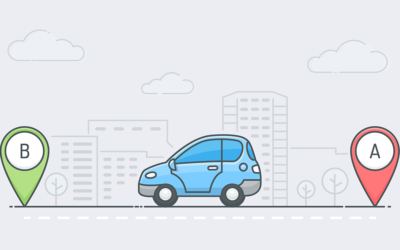Advancing Vision Zero: The Power of Contextual Data
Many patterns and trends related to how individuals and communities function abruptly changed due to the pandemic. Movement patterns of people and goods, traffic volumes, and roadway safety were no exception. The year 2020 experienced record level drop-offs in nationwide traffic volumes while traffic-induced fatalities remained consistent, even climbing at some points. This decrease in roadway volumes naturally made sense due to less time spent commuting, travelling, and dining in; however, reasons behind increasing rates of traffic fatalities weren’t as clear.
From July to September of 2020, traffic-induced fatalities increased by a staggering 13% compared to the same period in 2019. Preliminary industry research digging into the correlations between traffic volumes and fatalities in 2020 found that contributing factors were related to more accounts of riskier driver behavior including speeding, impairment, and lack of seat belt use. Whether it be traffic safety trends before, during, or after pandemic-related interventions, the complexity in understanding and countering roadway crashes is significant and ongoing. Many agencies have adopted policies to work towards advancing Vision Zero, or similar objectives which leverage safety action plans, data analytics projects, cross-agency coordination, and educational campaigns to eliminate traffic injuries and fatalities altogether.
Although these initiatives are significant in and of themselves, comprehensive and coordinated efforts are needed to fully understand and tackle the dynamic nature of roadway safety. This has been exemplified through national safety trends in 2020, where even quieter streets saw an increase in fatalities. In an effort to support Vision Zero efforts, UrbanLogiq has made significant progress towards developing tools that assist transportation professionals to proactively identiy high-risk areas and uncover correlations for safer streets.
What makes a road dangerous?
In 2019 UrbanLogiq partnered with the City of San José to answer the questions: what makes some streets so dangerous and how can San José reduce the severity of crashes on those streets? Through this work, we found that contextual factors had the largest predictive power in determining whether or not a roadway in the City of San José would have a severe or fatal collision. For example, road features such as stop signs (as opposed to signalised intersections) and road conditions (potholes, turn angle) explained 14% of a road’s collisions, while contextual features such as tall buildings, rainy weather, and high pedestrian traffic explained 56% of a road’s collisions.
As contextual factors are uniquely dependent on the characteristics and nature of the area in question, these outcomes call for an emphasis on using a proactive and comprehensive approach. For example, each roadway has unique properties such as road quality, surrounding infrastructure, and population density; meaning, a granular understanding of each roadway can significantly help to identify safety risks and potential interventions that align with a given area.
The consequences of not fully understanding the characteristics of the area in question can result in projects and countermeasures that are not fit for a given area. For example, in some cases a batch of identical countermeasures may be deployed in a number of high-profile areas without fully quantifying the nature of each area, resulting in inconsistent or even negligible impacts on safety. As the return on investment of these initiatives are often not able to be quantified until a before/after study is completed, there can be a significant lag before the impact of an intervention is fully known. As a result, a comprehensive approach is needed where the area in question, including its contextual factors, are fully known. Not only does this allow for more tailored safety measures but also sufficient data to benchmark expected versus actual performance and estimate return on investment for the community.
Countering contributing factors
In order to further operationalize this data-driven approach, UrbanLogiq partnered with a local academic institution to explore how the below questions can be easily answered for any given region:
- How can we actively identify which intersections are most dangerous?
- What are the main contributing factors leading to collisions for each intersection?
- What methods can be used to identify future high-risk intersections?
The project used data that is readily available for most jurisdictions, in this case, that included 10 years’ worth of crash data alongside traffic data and contextual data (demographics, zoning, infrastructure, etc.) within a specific test city. Through normalizing and integrating this information, a ‘Danger Score’ was constructed for each intersection across the city. This serves as valuable baseline information which can be updated in real-time, providing interpretable crash severity indicators for all intersections.
Not only does this baseline information provide a comprehensive look at crash probability for all intersections, but also allows safety professionals to understand the unique factors that are and/or will lead to higher crash probability. For example, two intersections may be designed almost identically and expect to have similar safety outcomes, but one may have far higher traffic volume or surrounding density which can contribute to higher crash probability. As a result, traffic safety efforts can be directed more effectively through using a comprehensive approach with readily available baseline data and active identification of existing and future high-risk intersections.
Initial results of this research indicate that each intersection has unique factors that contribute to crash probability, suggesting that incorporating a local, data-driven approach is critical. For example, each area in a community has a distinct mix of amenities, roadway characteristics, zoning bylaws, and, as such, each area needs to be fully understood in order to ensure interventions such as countermeasure devices make sense for a given area. Taking into account local contextual factors alongside a robust mix of roadway safety initiatives can help agencies better quantify the current and future state of roadway safety, identify needed safety improvements, and use a proactive approach to identify areas that may have a rising crash probability.
Interested to learn more?
UrbanLogiq is a cloud-based software solution that integrates and visualizes data to provide fast insights for government. Contact us today to schedule a personalized demonstration of the UrbanLogiq platform in action.



